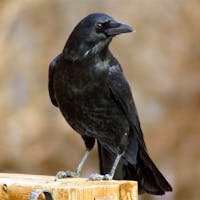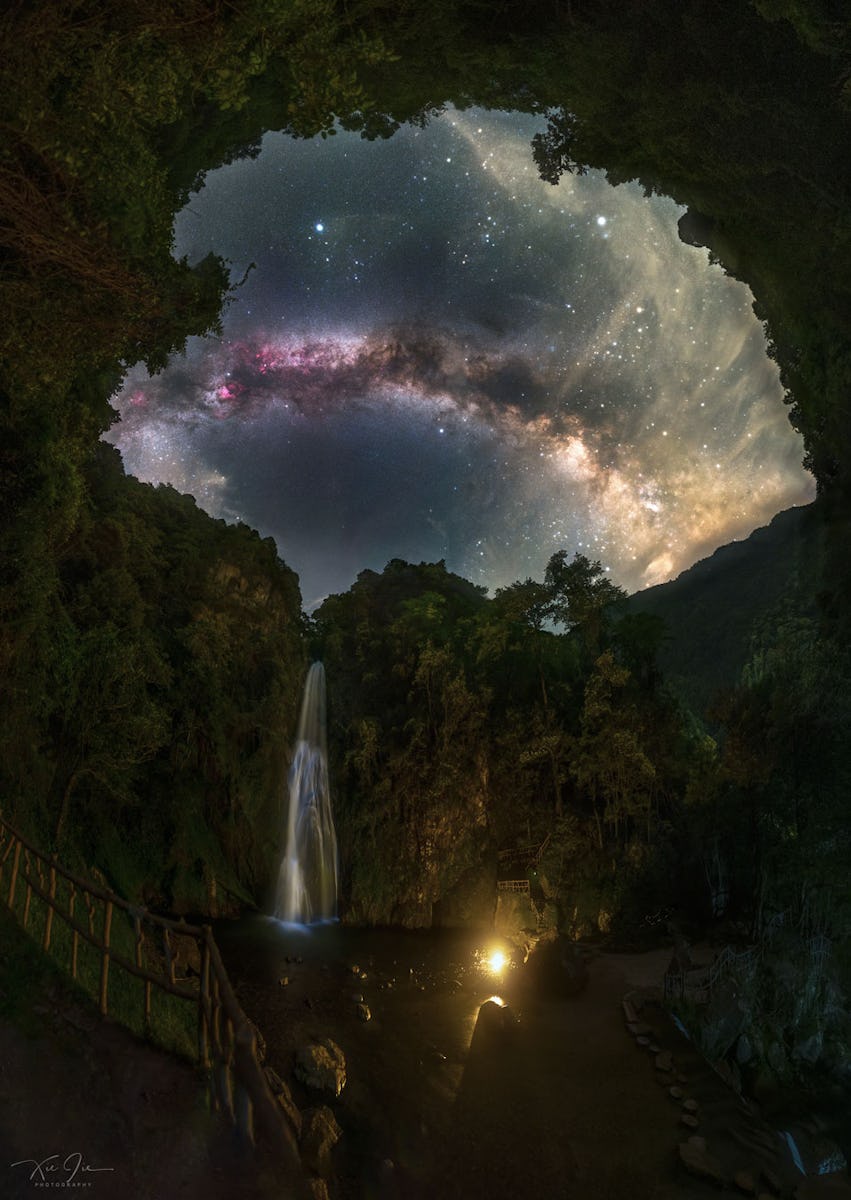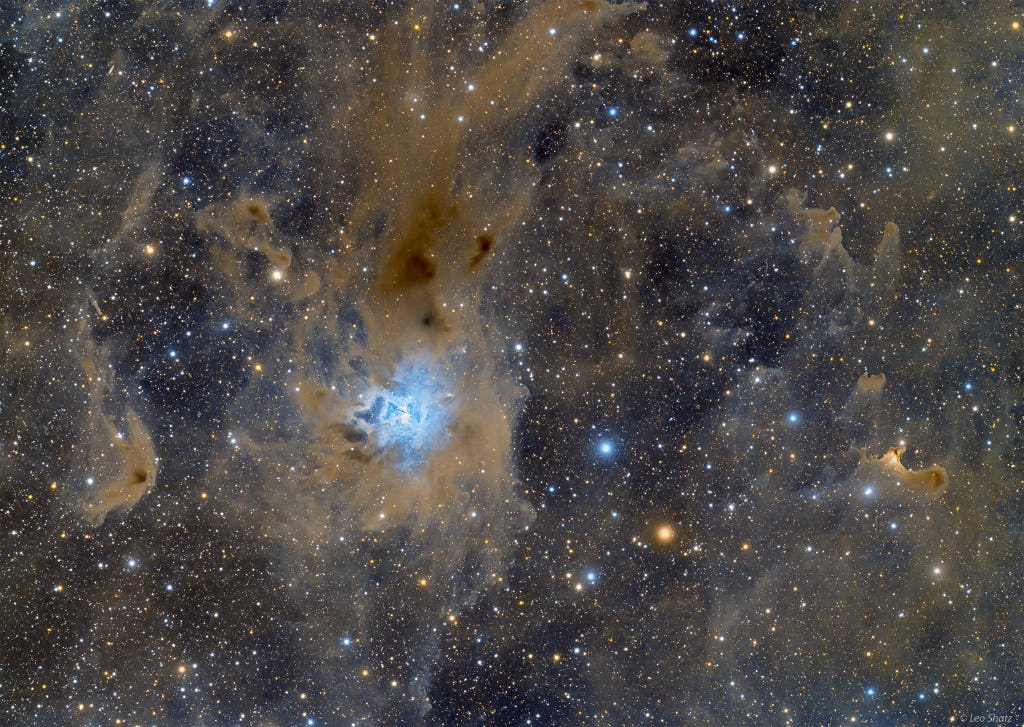Public Posts Seattle, WA Seattle, WA (zoom)
NASA Astronomy Picture of the Day:
The dream was to capture both the waterfall and the Milky Way together. Difficulties included finding a good camera location, artificially illuminating the waterfall and the surrounding valley effectively, capturing the entire scene with numerous foreground and background shots, worrying that fireflies would be too distracting, keeping the camera dry, and avoiding stepping on a poisonous snake. Behold the result -- captured after midnight in mid-July and digitally stitched into a wide-angle panorama. The waterfall is the picturesque Zhulian waterfall in the Luoxiao Mountains in eastern Hunan Province, China. The central band of our Milky Way Galaxy crosses the sky and shows numerous dark dust filaments and colorful nebulas. Bright stars dot the sky -- all residing in the nearby Milky Way -- including the Summer Triangle with bright Vega visible above the Milky Way's arch. After capturing all 78 component exposures for you to enjoy, the photographer and friends enjoyed the view themselves for the rest of the night. Discovery + Outreach: Graduate student research position open for APOD
Photo by Xie Jie
Alfred Tennyson, 1st Baron Tennyson (1809 -1892) - British poet who become the most popular poet of the Victorian era and remains one of the most popular British poets.
NASA Astronomy Picture of the Day:
Is our universe haunted? It might look that way on this dark matter map. The gravity of unseen dark matter is the leading explanation for why galaxies rotate so fast, why galaxies orbit clusters so fast, why gravitational lenses so strongly deflect light, and why visible matter is distributed as it is both in the local universe and on the cosmic microwave background. The featured image from the American Museum of Natural History's Hayden Planetarium Space Show Dark Universe highlights one example of how pervasive dark matter might haunt our universe. In this frame from a detailed computer simulation, complex filaments of dark matter, shown in black, are strewn about the universe like spider webs, while the relatively rare clumps of familiar baryonic matter are colored orange. These simulations are good statistical matches to astronomical observations. In what is perhaps a scarier turn of events, dark matter -- although quite strange and in an unknown form -- is no longer thought to be the strangest source of gravity in the universe. That honor now falls to dark energy, a more uniform source of repulsive gravity that seems to now dominate the expansion of the entire universe. Not only Halloween: Today is Dark Matter Day.
Photo by Tom AbelRalf KaehlerKIPACSLACAMNH
Three ants on a twig,
struggle with the breeze.
Next time, one said
we will stay with the trees.
A Comment by Loy

Cute! :)
A Comment by MFish

Thank you. The brain is running on fumes
You told me last night,
you'd be dead in 2 weeks.
Why do you say such
ridiculous words?
Are you angry with me?
Is that what it is? I hope not,
for I give what I can give.
I find it funny,
in an odd kind of way
You will talk to others,
but do not say,
anything to me.
You are polite
and courteous to me
as your customer.
The coldness I feel,
is probably just me.
If I have offended you,
I'm sorry.
Heritage at sea - Must we simply accept the loss of beloved buildings and cities to the floods and rising seas of the climate crisis?|| by Thijs Weststeijn :: AEON
"...Old Amsterdam has survived in a remarkably pristine fashion the wars and urban development that affected many other European cities. But for the past year or two, I have noticed that my students’ appreciation of the city’s visible antiquity has acquired a new dimension. This monument to human ingenuity, which rests on thousands of wooden poles hammered into the marshy soil, now seems to have a longer past than it does a future". Read more
"I live near Seattle and for the first time since 1924, Seattle has an NHL franchise. Now hockey is the sport everyone here is talking about. The team is called the Seattle Kraken.If you’re like most hockey fans, you probably have many questions" Read more
NASA Astronomy Picture of the Day:
If you see this as a monster's face, don't panic. It's only pareidolia, often experienced as the tendency to see faces in patterns of light and shadow. In fact, the startling visual scene is actually a 180 degree panorama of Northern Lights, digitally mirrored like inkblots on a folded piece of paper. Frames used to construct it were captured on a September night from the middle of a waterfall-crossing suspension bridge in Jamtland, Sweden. With geomagnetic storms triggered by recent solar activity, auroral displays could be very active at planet Earth's high latitudes in the coming days. But if you see a monster's face in your own neighborhood tomorrow night, it might just be Halloween.
Photo by Göran Strand
NASA Astronomy Picture of the Day:
Spooky shapes seem to haunt this dusty expanse, drifting through the night in the royal constellation Cepheus. Of course, the shapes are cosmic dust clouds visible in dimly reflected starlight. Far from your own neighborhood, they lurk above the plane of the Milky Way at the edge of the Cepheus Flare molecular cloud complex some 1,200 light-years away. Over 2 light-years across and brighter than most of the other ghostly apparitions, vdB 141 or Sh2-136 is also known as the Ghost Nebula, seen at the right of the starry field of view. Inside the nebula are the telltale signs of dense cores collapsing in the early stages of star formation. With the eerie hue of dust reflecting bluish light from hot young stars of NGC 7023, the Iris Nebula stands out against the dark just left of center. In the broad telescopic frame, these fertile interstellar dust fields stretch almost seven full moons across the sky.
Photo by Leo Shatz
There was a time
when I believed my Soul
was being held hostage.
Don't ask me to explain,
for I'm not sure I can;
it is the sub-conscience
of an old, old man.








.jpg?fit=crop&w=280&h=280&q=93)











.jpg?fit=crop&w=200&h=200&crop=faces)






 - Copy.jpg?fit=crop&w=280&h=280&q=93)














